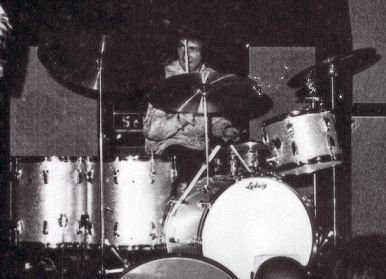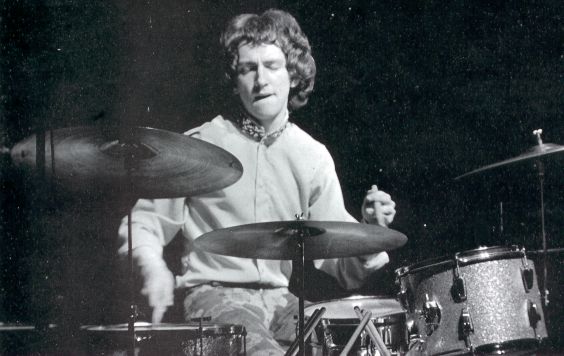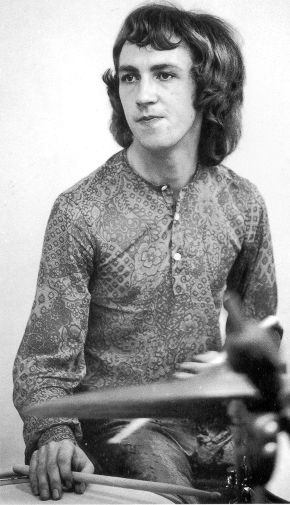
Jimi’s Man
A child actor, Mitch was largely self taught, though he received some lessons when he worked in Jim Marshall’s (the Amp man) music store. Mitch did some free lance work before settling in with Georgie Fame and the Blue Fames. One of the great UK jazz inflected R&B bands. After 18 months George fired the whole band as management wanted a change in direction. The next day Mitch got a call from Chas Chandler to come and try out with this American he was managing. Mitch was invited to join for two weeks work touring France. One of the great musical synergies was born.
Jimi Hendrix has a magnificent rhythmic drive, his playing sets the groove. He also has a strong idea what the bass player is to play. Indeed he is a pretty good bass player himself as on several tracks he replaced Noel Redding and recorded the bass himself ("All Along the Watchtower", "1984…"). With Jimi setting the groove and the bass player holding it and following his lead, the drummer had great opportunity to fill and interact. Jimi and Mitch are closer to Townshend and Moon, then with Cream (Baker had two lead guitarists!).

Mitch is a jazz influenced player, especially Elvin Jones but also Max Roach and Joe Morello. He uses the underhand or military grip switching to matched for tom work. He used a variety of kits: first Premier with 20" bass & 14x 8" top tom, then a Ludwig Silver Sparkle in the classic jazz setup: 22" bass, 13x9" top, 14x14" & 16x16" floor, Ludwig Supra-phonic snare. Cymbals varied but typically: 15" Hi-hat, 20" ride, 20" & 22" crash and later a 22" or 24" riveted ride. In 1969 he moved to a Ludwig double bass kit with 24" bass drums and additional 12x8" top tom, then the same setup on Gretsch (possibly Ludwig sponsorship in Europe and Gretsch in USA). The double kit didn't change his style, it just added some tonal variety. Sticks were medium/heavy and he played seated low in a hunched position.
Mitch plays in the Elvin Jones explosive style with fast snare and cymbal riding coupled with more basic rock triplet bass patterns and big bombs. In line with jazz drumming he played within the snare/hi-hat/ride cymbal/bass drum arc with the toms as variations. His hi-hat and cymbal work is of the highest order and he used brushes on occasions. He is criticised as a busy drummer which is grossly overstating the case. More restrained drumming may have been more appropriate on a few tracks (that’s Mitch’s opinion). I really can’t describe them as flawed, just that it could have been done differently and that doesn’t mean better!

The thing that Mitch had was incredible stamina especially in the studio as Hendrix endlessly worked though songs. He always responded to Hendrix’s variations and worked from his arrangement. Mitch never defined his arrangement within the song – he bounced off Jimi. Live was the same, as it was need to follow Hendrix’s improvisations and also fill in those gaps, especially when Hendrix did his stage act. It was behind these that Mitch took his solo over a droning bass line, usually at an exciting high tempo. He was a fast drummer – lightning at times and surprisingly loud for his diminutive statue. But as a true soloist he could not retain momentum – the solo on "Voodoo Child" looses momentum surprisingly quickly. This is a result of the lack of thorough formal training and the techniques that it provides to build a coherent solo - a limitation of no relevance in this band.
Mitch’s critical asset was his explosive, intuitive responsiveness to Jimi. He could lay down a strong, lithe groove but then instantly react as Hendrix shifted gears or moved off in another direction. His style is in stark contrast to Buddy Miles who lays down a relentless groove which, when combined with the solid groove bass playing of Billy Cox, stultified Hendrix. Mitch’s return freed up Hendrix and Billy Cox as well. I really cannot conceive of Baker playing this sort of role – his personal rhythmic impetus would also have impeded Hendrix but not as greatly as Miles.
After Jimi died, Mitch languished in some ordinary projects. The one that had the greatest potential was the Jack Bruce/Larry Coryell/Mitch Mitchell/Michael Mandell jazz/rock fusion band. The available bootlegs show Mitch playing in a jazzier style with some Bakerish inflections with the tom fills. What I find most interesting is that the rhythmic drive is coming from Jack, allowing Mitch to fill, reinforce and explode but in a controlled way. That was a good band that should have gone on but Jack got the irresistible call to join the Tony Williams Lifetime.

The third of the great British Rock drummers of the ‘60s, with a very different style and technique. His legacy is an indispensible part of that of Jimi Hendrix’s …’nough said.
Greatest moments: "Manic Depression", "Fire", "Crosstown Traffic" (the groove), "Hey Baby (New Rising Sun)"and the BBC sessions.
Historical Footnote: Ginger and Mitch were not rivals, in fact they were friendly members of the drummers club. On the night that Jimi died, they had picked up Sly Stone from London airport and were looking for Jimi to participate in a jam.

© Graeme Pattingale 1999